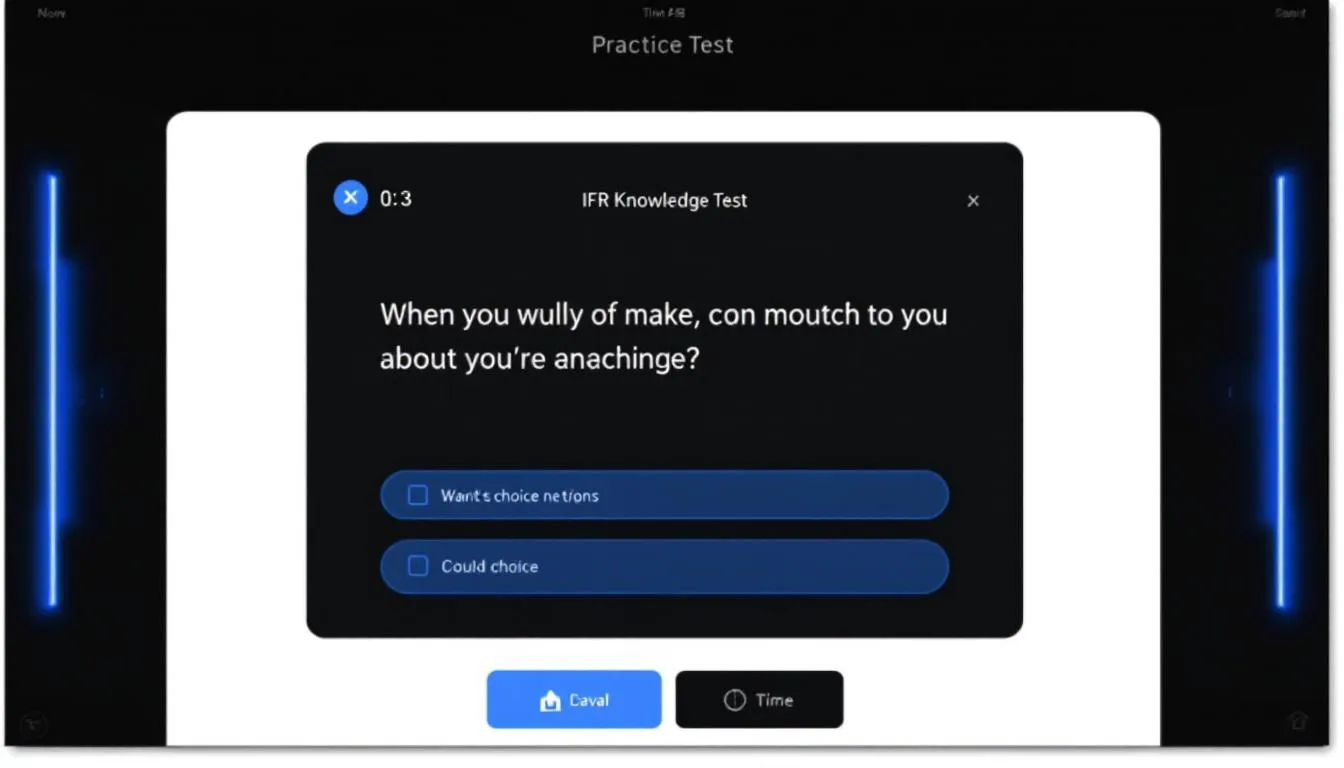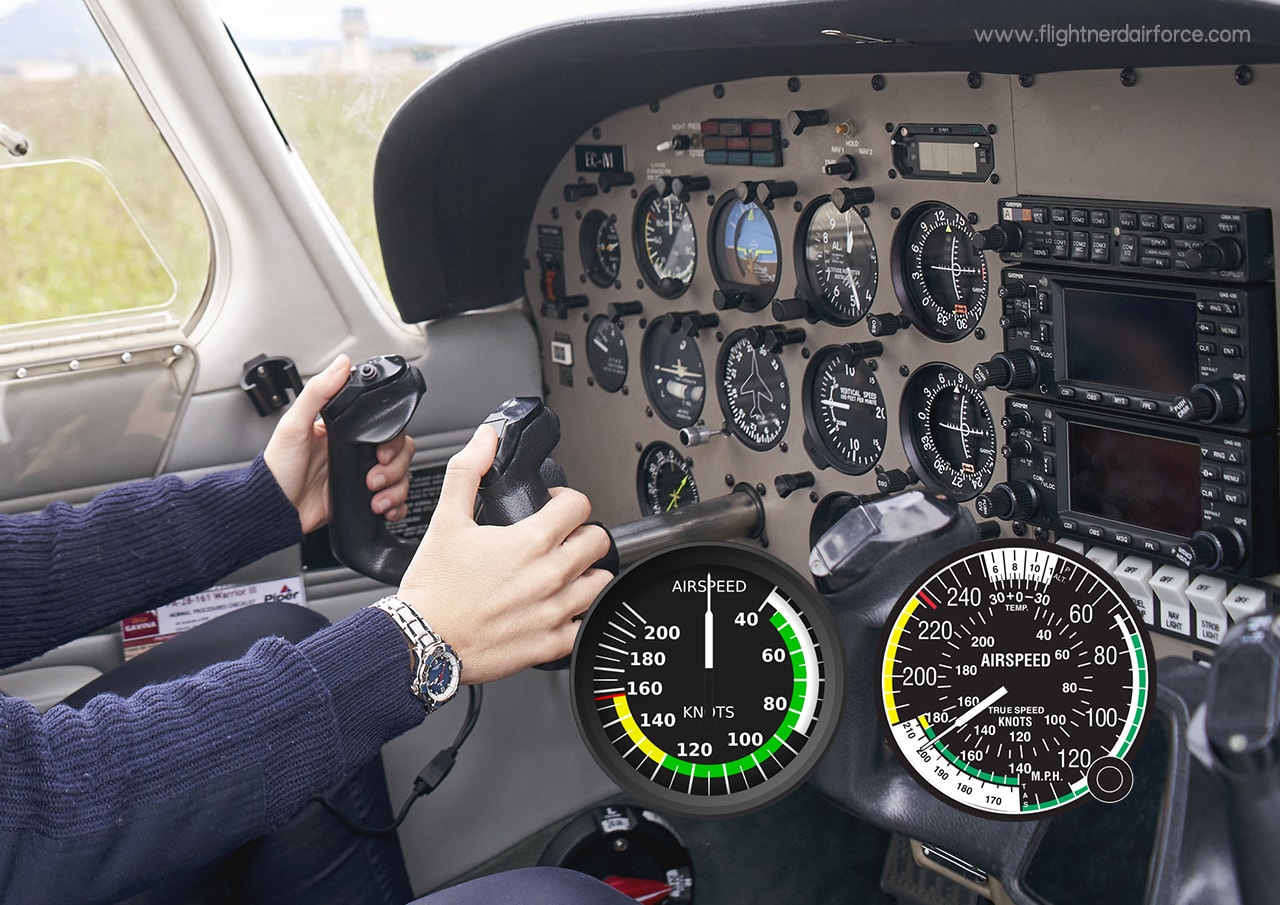Practice IFR Test: Improve Your Skills with Realistic Prep
Aug 05, 2025
Want to ace your IFR Knowledge Test? Our practice IFR test with 40 questions will help you prepare effectively, boost your skills, and build confidence.
Highlight
-
The FAA Instrument Rating Knowledge Test covers all the IFR flying topics, you need to score at least 70% to pass, so preparation is key.
-
Using practice tests and multiple study resources, online courses and simulators will help you understand and identify knowledge gaps.
-
Good study habits, time management, group study and attention to detail will help you avoid common mistakes and pass the IFR Knowledge Test.
Understanding the IFR Knowledge Test

The FAA instrument rating exam, also known as the IFR Knowledge Test, is a multiple-choice exam that tests your knowledge of various aviation topics for IFR flying.
65 questions long it covers everything from navigation and weather to FAA ( Federal Aviation Administration) regulations and procedures. You need a 70% to pass so preparation is key.
Instrument ratings are part of your journey as a pilot so you need to have the knowledge to fly safely. Practice tests will help you identify your strengths and weaknesses. Not preparing adequately can result in failing the test.
These tests are in the same format and content as the actual test so you can get used to the type of questions you will see.
The IFR Knowledge Test is known to be difficult and requires thorough preparation, including understanding the proper procedures for receiving and following an IFR clearance.
Once you have completed the necessary preparation and training, you will be ready to take the IFR Knowledge Test.
Scheduling Your IFR Knowledge Test
Scheduling your IFR Knowledge Test is easy:
-
Go to the FAA website to book your test.
-
The tests are administered by PSI Services, a third-party testing provider for the FAA.
-
Don’t forget to bring a state or federal government-issued photo ID to the test to verify your identity.
In the case that a pilot forgets to bring the required ID, they will not be allowed to take the test and will need to reschedule.
Have all this info ready and you can focus on doing your best when you get to the test.
Preparing for the IFR Knowledge Test
Preparation is everything when it comes to passing the IFR Knowledge Test. A combination of study resources like online courses, study guides and practice test platforms is key to understanding the material.
This combination will cover all the topics and have you ready for any question that comes your way. Be sure to keep a log of your study hours and progress to track your improvement and ensure you are covering all required areas.
Practice tests are especially helpful. These tests not only get you used to the test format but also help you identify what you need to study more. Many pilots choose to purchase additional premium test prep materials to deepen their understanding and simulate real test conditions.
If you’re a private pilot, consistent practice and review will boost your confidence and performance and have you ready for the IFR Knowledge Test. The result of thorough preparation is increased confidence and a higher likelihood of passing the test.
Instrument Rating
Getting your instrument rating is a big deal in your pilot training. This advanced rating shows you can navigate and fly an aircraft using only instruments, even when outside visual references are gone.
The instrument rating exams are tough, with a lower national pass rate than other FAA exams. They test your understanding of air navigation, weather interpretation and FAA regulations.
But with focused training and the right study plan you can increase your chances of passing. Comprehensive courses like the ones offered at Sheppard Air cover all IFR topics, including real world scenarios and detailed explanations.
Many pilots also enhance their skills through CFII training, which prepares them to become certified instrument flight instructors.
Practice tests are especially valuable, so you can see how ready you are and target areas that need work. By dedicating time to study, using good resources and practicing with realistic tests you’ll be ready to pass the instrument rating exams and take your flying to the next level.
Top Practice Questions for IFR Test

The best way to prepare for the IFR Knowledge Test is to practice with a full set of questions that mimic the actual test.
These questions will test your knowledge of key topics and have detailed answers and explanations to help you understand the material.
Go through these questions and you’ll find out your strengths and weaknesses so you’ll be ready for the exam. You can revisit this page anytime as a reference for your study.
Below are the top 40 questions divided into three areas: Navigation and Flight Planning, Weather and Meteorology, and Regulations and Procedures. Each question has an explanation to help you understand the answer.
Question Set 1: Navigation and Flight Planning
Navigation and flight planning is key. Knowing visibility requirements, minima, and the correct frequencies for navigation and communication is critical for safe and efficient flight.
Locating the appropriate frequencies or positions during flight planning ensures you can maintain communication and navigate accurately.
For example, visibility for 33 is 1 mile and minima is 1240 MSL. These numbers will help you plan your approach and landing, and identifying the correct point for beginning an arrival route or changeover is essential.
Another one is the min EN route altitude (MEA) on V520 which is 15,300 feet. This altitude will clear obstacles and give you radio signal. VOR ground stations transmit signals that help determine an aircraft's position, but be aware of potential errors caused by these signals at high altitudes or certain angles.
An IFR flight must be at least 1,000 feet above the highest obstacle within 5 miles of a VOR station for safety.
Knowing procedures like the RNAV (GPS) RWY 36 approach course reversal is important:
-
Course reversal is at 4 miles from FEHXE.
-
Familiarity with these procedures will help you navigate and communicate during your flight.
-
To contact Denver Center near the Cortez VOR use 118.575.
When flying STARs or approach procedures, you may be instructed to join a STAR as part of the arrival process, which helps coordinate a safe and efficient approach.
Knowing these will make a big difference in your flight planning and execution.
Question Set 2: Weather and Meteorology
Weather and meteorology is critical to flight safety and navigation. Knowing the weather can make all the difference to your flight plans and decisions.
Flying in stable air is smooth and predictable but can also mean reduced visibility and lower cloud ceilings. Knowing this allows you to make informed decisions on your route and altitude.
Conversely cumuliform clouds means unstable air and potential turbulence and changing weather.
Abrupt changes in weather or sudden aircraft maneuvers can create illusions that affect pilot perception, making it essential for pilots to recognize and manage these effects.
These clouds can mean thunderstorms, which is a big risk to flight safety visibility can be blocked entirely in such conditions.
By knowing these weather concepts you can anticipate and respond to changing weather during your flight.
Question Set 3: Regulations and Procedures
Regulations and procedures are the backbone of safe and efficient flying. The FAA Knowledge Test covers:
-
Aircraft systems
-
Weather
-
Navigation
-
Federal Aviation Regulations
Knowing these regulations means you can fly within the legal and safe boundaries.
For example, the types of airspace on the En Route Low Altitude Chart are controlled airspace, Military Training Routes (MTRs) and special use airspace.
In some instrument system malfunctions, static and dynamic pressure readings may become equal, which can affect the accuracy of your instruments.
Knowing the minimum altitude for off-airways IFR over mountains is important; 2,000 feet above the highest obstacle within 4 miles, which can be 1,000 feet if more than 4 miles from the mountains.
Master these and you’ll pass the IFR Knowledge Test and fly safely under the hood.
Key Concepts to Master for IFR Success

IFR requires you to learn key concepts. The IFR Knowledge Test covers navigation, regulations and weather, all of which are essential for safe flight.
A structured study schedule with set times for review and practice will help with retention and understanding.
Practicing with practice tests identifies knowledge gaps and reinforces understanding so you can focus your study and improvement.
Popular IFR books often include explanations of flight regulations, procedures and real world scenarios to help you understand. For high-altitude IFR flights, oxygen must be provided to the crew and passengers as required by regulations.
Approach and Departure Procedures
Approach and departure are critical for managing aircraft transitions during the most important phases of flight.
Standard IFR procedures like STARs (Standard Terminal Arrival Routes) and SIDs (Standard Instrument Departures) are pre-defined routes that help you transition to and from the airport as you arrive.
These will get you through takeoff and landing safely and quickly.
Emergency Operations
Knowing emergency procedures is key to staying safe in an emergency. Basic instrument maneuvers can be flown by reference to instruments only, especially in an electrical failure.
For example, in an electrical failure with an Electronic Flight Display, the altimeter is the primary pitch instrument.
Anti-ice systems must be monitored in icing conditions. Pilots must act fast to change altitude or divert when icing is detected without de-ice equipment.
In-flight emergencies require immediate and decisive action to stay safe, and mastering these scenarios will reduce risk straight away, especially when operating an airplane in limited visibility, system failure situations, or when forced to return to the ground unexpectedly.
In some emergencies, pilots must act immediately to ensure safety.
Effective Study Strategies for IFR Test
Effective study strategies are the foundation of test prep. Thorough prep builds confidence and reduces errors on the test. Some IFR test prep courses even offer a money-back guarantee if you are not satisfied with your results.
Many candidates underestimate the importance of consistent review and practice which is key to not making common mistakes. Consistent study and review is key to not being under prepared for the IFR test and scoring lower.
The Instrument Rating Practice Exam is designed to test a pilot’s readiness for the FAA written exam. Using practice tests helps you identify knowledge gaps so you can focus your study and improve.
Time Management Techniques
Time management is crucial during the IFR Knowledge Test. Many pilots rush through answers and make mistakes.
Understanding each question helps you avoid misinterpretations that can affect your score.
Develop time management skills and you’ll do better on the test.
Utilizing Practice Tests
Practice tests will help you get used to the test format and types of questions. Resources and methods include:
-
PSI practice exams to get used to the test format and question types.
-
Interactive flight simulators that provide scenario based training.
-
Online courses that allow you to practice IFR maneuvers in a virtual environment.
Some online practice test platforms also allow you to send your questions or feedback directly to instructors for clarification.
Read the questions carefully, especially the coded weather information, small mistakes can make a big difference.
Misinterpret the context of a question and you’ll get the answer wrong; read for clarity.
Take multiple practice tests and you’ll get used to the exam format and be able to interpret the questions correctly.
Resources for IFR Training

Here are some:
-
Books
-
Online courses
-
Simulators
-
Mobile apps to help you learn
Using multiple resources will make you more prepared for the IFR Knowledge Test and more confident as a pilot.
These resources provide a structured learning path and all the materials you need to learn IFR. You can also receive important updates and endorsements through these training platforms. Combining different resources will cover everything and get you ready for the test.
Recommended Books and Guides
Recommended books and guides provide structured and in depth knowledge for IFR training.
One of the most popular is the book ‘How to Fly IFR’ which covers topics such as flight planning, instrument flying and handling different types of airfields.
The 2025 edition has an updated table of contents so the content is more readable.
This guide is practical and explains the how and why of IFR procedures.
Online Courses and Simulators
Online courses and simulators are a must for IFR training. These courses offer structured learning paths, comprehensive materials and interactive components like quizzes and video tutorials to reinforce learning.
Flight simulators give you real world applications to:
-
Practice navigation and instrument flying without the risk
-
Practice scenarios that mimic real life situations to improve decision making
-
Build confidence through repetition
Mobile Apps for On-the-Go Study
Mobile apps allow on the go study, so you can access study materials and practice questions anywhere.
Apps with flashcards and practice tests let you study IFR and take quizzes anytime and anywhere. Perfect for busy pilots who need to make the most of their study time.
Common Mistakes to Avoid During IFR Test
Mistakes during the IFR Knowledge Test can cost you. Misreading questions is a common error that leads to unnecessary mistakes.
Knowing these pitfalls and studying hard can help you avoid them and do better on the test. Studying hard and paying attention to details is key to passing the IFR Knowledge Test.
Reading carefully and practicing with tests can help you avoid these mistakes. Consistent review and attention to small details will have you ready to crush the test.
Misinterpreting Questions
Misreading questions leads to wrong answers. The sterile cockpit rule helps pilots focus on critical phases of flight, just like reading questions carefully during the IFR Knowledge Test.
Practicing with different question types helps you improve your question interpretation skills, just like the sterile cockpit rule helps you focus in flight.
Pay attention to details; misread one word in a tricky multiple choice answer and you’ll make unnecessary mistakes.
Inadequate Preparation
Not being ready can lead to low confidence on the IFR Knowledge Test and failure. Common mistakes from not being ready are misreading questions and missing small details.
Having a study schedule and using practice tests can make a big difference.
Regular review and practice of key concepts is key to solidify knowledge and build confidence.
Summary
In summary the IFR Knowledge Test is a big part of your journey to becoming a pilot. Being ready with many resources like books, online courses, simulators and mobile apps can make a big difference.
Practicing with real test questions and mastering key concepts like navigation, weather, regulations and emergency procedures are key.
Don’t make common mistakes like misreading questions and missing small details and be ready and you’ll walk into the IFR Knowledge Test with confidence.
Remember consistent study and practice is key. Take the challenge, use the resources and fly high in your aviation career.
